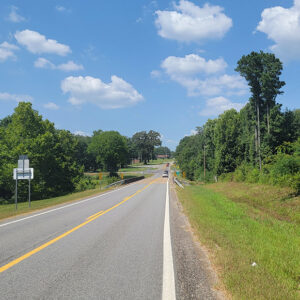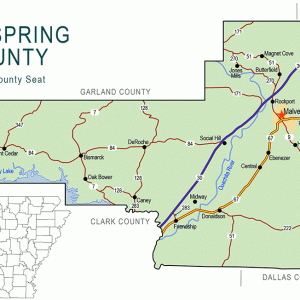calsfoundation@cals.org
Caney (Hot Spring County)
Caney is an unincorporated community in southwestern Hot Spring County. Centered on the intersection of Arkansas Highways 128 and 283 and Caney Road, the community is about one mile north of the Clark County line and seven miles southeast of Bismarck (Hot Spring County). The community is located in Montgomery Township and is about two miles east of DeGray Lake.
Early landowners in the area included John Riddles, who obtained a federal land patent for 160 acres in the area in 1856. (Riddles is also spelled Riddle in some documents.) Little information on John Riddles is available, but other Riddles family members in the area also obtained land patents around the same time. Eli Riddles received a land patent for 240 acres in 1859. In the 1860 federal census, he is listed as a farmer with his wife and son, with $400 of real estate and $250 of personal property. In the census, Eli appears as E. A. Riddle McKinnon.
Other McKinnons appear in the 1860 census, and Laughlin McKinnon obtained 120 acres of land that same year. Laughlin is not listed in the census but is likely related to the other McKinnons in the area.
William Lowe, along with his wife and four daughters, obtained a land patent for just over 114 acres in 1859. The next year, his estate was recorded as $400 of real estate and $300 of personal property.
A school operated in Caney in the late nineteenth and early twentieth centuries, although details on the exact location and dates of operation are unavailable. The community later split into two school districts. Students residing on the east side of Caney began attending the Ouachita School District located in Midway (Hot Spring County), with students on the west side attending school in Bismarck.
A post office operated in Caney for a single year, 1910 to 1911. Service is provided by the Bismarck Post Office in the twenty-first century.
Founded in 1897, Caney Missionary Baptist Church, located just north of the intersection of Highways 128 and 283, became the hub for many community events. Caney Cemetery is located east of Caney Missionary Baptist Church, with graves dating to 1886. It continues to be used in the twenty-first century.
The community is primarily residential with no businesses. Residents commute to employment in other nearby towns. Much of the area is covered in timber, which remains an important industry in the area.
For additional information:
“F.L. Smith, Lawyer.” The Heritage 28 (2001): 117–119.
Matlock, Carl. “Caney School.” The Heritage 33 (2006): 47, 68.
McGlone, Callie Mae Keeton. “My Childhood Life.” The Heritage 34 (2007): 59–68.
Montgomery, Ray. “My Memories of DeRoche.” The Heritage 31 (2004): 49–53.
David Sesser
Southeastern Louisiana University
 Caney Church
Caney Church  Caney Creek
Caney Creek  Hot Spring County Map
Hot Spring County Map 




Comments
No comments on this entry yet.